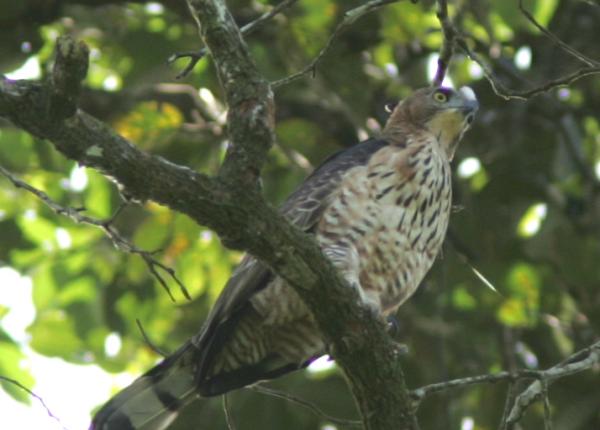Did You Know?
- There are two recognized subspecies of Wallace's Hawk-eagles
- This species does not migrate
How The Peregrine Fund is Helping
Though The Peregrine Fund does not work directly with Wallace's Hawk-eagle, our efforts in scientific research, habitat conservation, education, and community development help conserve birds of prey around the world. We also supply literature to researchers from our avian research library, which helps scientists around the world gather and share important information on raptor conservation. Our support of the Global Raptor Information Network gives raptor researchers tools to more efficiently conduct their own studies while contributing to a global program. It also provides citizen scientists a way to participate in raptor science and conservation.
Where it Lives
The Wallace's Hawk-eagle is found throughout much of the Indomalayan region. It makes its home in dry-land evergreen and semi-evergreen lowland forest. It spends time in both undisturbed and logged forests, and even in heavily degraded sites. However, it tends to stay near to access to patches of continuous high canopy.
Why it Needs our Help
This species is categorized as Vulnerable. It is threatened by loss of habitat due to logging, land conversion, and even fires.
What it Eats
This hawk-eagle has a varied diet and will prey on lizards, birds, bats, squirrels, frogs, and skinks. Though a lot remains to be learned about this species' hunting habits, it is likely that, when on the hunt, it sits patiently on a perch waiting for an opportune moment to pounce on its prey .
Nests, Eggs and Young
This eagle builds a medium-sized stick platform-shaped nest, placed in a branch, often in an emergent tree. The adults will line the nest cup with fresh, leafy branches throughout the nesting period, until the nestling is grown. Scientists still don't know a lot about the breeding habits of this species. Though all the documented nests to date have had just one nestling, we don't know if they only lay only one egg or more. We also don't know how long the incubation and fledging periods are, if both parents care for the eggs and young, or how long the young are dependent on the adults.
Wallace's Hawk-eagle and the World Center for Birds of Prey
Though far from the Wallace's Hawk-eagle distribution, the World Center for Birds of Prey does have a different species of hawk-eagle for you to meet. A visit to the center will award you with an opportunity to meet Tulio, our resident Ornate Hawk-eagle who hatched in late Spring 2021. At the visitor center, you will see this amazingly colorful bird of prey up close in our outdoor aviary. Come learn about this unique species, what makes a hawk-eagle a hawk-eagle, and more!
References:
Clark, W. S. and G. M. Kirwan (2020). Wallace's Hawk-Eagle (Nisaetus nanus), version 1.0. In Birds of the World (J. del Hoyo, A. Elliott, J. Sargatal, D. A. Christie, and E. de Juana, Editors). Cornell Lab of Ornithology, Ithaca, NY, USA. https://doi.org/10.2173/bow.walhae1.01
Global Raptor Information Network. 2023. Species account: Wallace's Hawk-eagle Nisaetus nanus. Downloaded from http://www.globalraptors.org on 25 Jun. 2023









